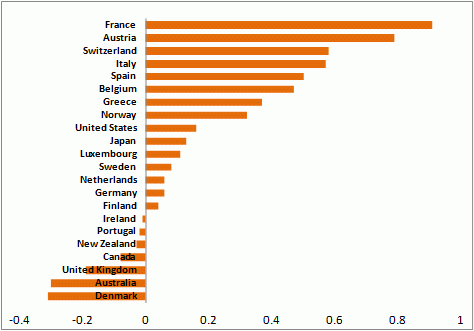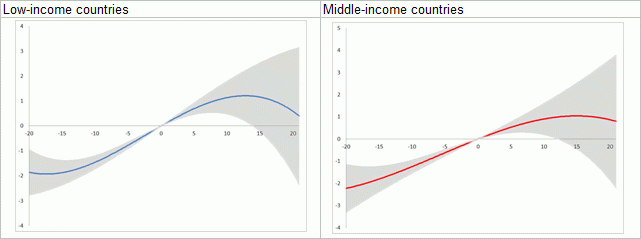The onset of the global financial crisis raised widespread concerns that donor countries would reduce aid flows to developing countries. The presumption was that expenditure stimulus packages aimed at quelling the crisis coupled with revenue shortfalls caused by lower growth, would strain donor budgets, causing them to cut aid flows. At the same time, demand for development aid was expected to increase as aid-dependent countries would likely face reductions in other sources of external financing, including exports, FDI, portfolio flows, and remittances. In this context, leaders of multilateral institutions called for averting aid cuts to avoid “crashing waves” in aid-dependent economies (IMF 2009, and World Bank 2009).
Although preliminary assessments of the immediate impact of the crisis on aid flows suggest that it was not as deleterious as expected, the potential risks of aid reductions are still present. The strength of the rebound from the current crisis in many advanced countries has been modest to date and could be hampered by Europe’s debt crisis, the natural disaster in Japan, and the strife in the Middle East. Therefore prospects for a self-sustaining recovery in economic activity in donor countries are prone to important downside risks, which in principle questions whether aid flows will be cut in the near future. But is there any systematic evidence about the relationship between cycles and large shocks in donor countries and aid flows?
The link between donor-recipient cycles and aid flows
To what extent do business cycles, growth, and financial crises in donor countries influence their foreign-aid contributions? Has this impact been large or persistent in the past? Furthermore, how do macroeconomic conditions in low-income countries influence their aid receipts? Finally, how are aid flows affected by large shocks in donors and/or recipient countries?
While the effect of donor financial crises in reducing aid outlays has been recently documented (Dang et al. 2009; Frot 2009), evidence on the impact of economic downturns in donors is less clear-cut. Economic downturns in donor countries do not necessarily imply reductions in aid flows (Mold et al. 2008; Pallage and Robe 2001). On the other hand, there are studies suggesting that development aid is procyclical with respect to output in aid recipient countries (Bulir and Hamann 2007; Pallage and Robe 2001).
New evidence of the impact of donor-recipient cycles and large shocks on aid flows
In a recent paper (Dabla-Norris et al. 2010) we study the impact of the business cycle in donor and recipient countries on aid flows. Our work brings to the existing literature two novelties:
- First we use data on bilateral aid flows which allows us to control for aspects of the donor-recipient relationship that are difficult to measure or observe and that explain a very large share of the variation of aid flows.
- Second, we explore the role of large adverse shocks on both recipient and donor countries in determining aid flows.
Our empirical analysis relies on a large dataset of 22 donors and 113 recipients over the period 1970–2005. Four results stand out from our paper:
- Bilateral aid flows are on average procyclical with respect to the donor output cycle. This means that aid tends to rise during economic expansions and fall during recessions, although the average conceals some heterogeneity (Figure 1). Further, when donors experience unusually adverse economic conditions – for instance a large negative output gap or GDP growth rates well below trend levels – aid disbursements are substantially reduced. These effects tend to be persistent, with large fluctuations in donor countries having a lasting effect – up to three years – on aid flows.
Figure 1. Impact of donor output gap on official development assistance disbursements
Note: These are coefficient estimates from an OLS regression of bilateral aid on donor GDP and population, donor output gap (estimated through a log-linear regression of GDP on time), country-pair fixed effects, and time effects. The dependent variable is defined as log-transformed bilateral net official development assistance excluding humanitarian aid, development food aid, and debt relief grants. Source: Authors’ estimates.
- There is a non-linear relationship between aid flows and the cycle in both donor and recipient countries. That is, aid disbursements fall during donor recessions but at decreasing rates (Figure 2). Nevertheless, the impact appears linear within regular values of the output gap, with the non-linearity only appearing at higher values of the output gap (of above +/- 10 percentage points of potential output).
Figure 2. Impact of donor cycle on aid flows (semi-elasticities)
Note: The two panels show coefficient curves representing the fitted relationship between the donor output gap (x-axis) and aid flows (y-axis), along with 95% confidence intervals (shaded areas). The underlying coefficient estimates come from an OLS regression of bilateral aid on donor GDP and population, donor output gap, country-pair fixed effects, and time effects; the dependent variable is defined as log-transformed bilateral net official development assistance excluding humanitarian aid, development food aid, and debt relief grants. The left-hand side panel refers to the regression on the sub-sample of low-income countries; the right hand-side panel refers to the sub-sample of middle-income countries. Source: Authors’ estimates
- High public debt levels in donor countries are associated with a contraction in aid flows in the aftermath of donor recessions. This pattern was apparent in the data despite relatively little historical variation in the donor business cycle and public debt levels.
- Bilateral aid flows are procyclical with respect to the recipient output cycle, but countercyclical when the recipient is hit by large adverse shocks, including terms-of-trade shocks or growth collapses. The pro-cyclicality result suggests that aid recipients tend to be “rewarded” for good macroeconomic performance with higher aid flows; whereas the counter-cyclicality result underscores the insurance potential of aid flows for developing countries when hit by large negative shocks.
Conclusion
In the context of the crisis-related economic downturn afflicting advanced economies, debt-related problems in Europe, a natural disaster in Japan and continued strife in the Middle-East, what do our results imply for the projected path of aid disbursements over the next few years? Given the unprecedented severity of all these events and problems, evidence from the past may not necessarily serve as the best basis for projections. Nevertheless, the empirical patterns we uncover in our research support the view that there are significant downside risks to the outlook for development aid. The aid community will need to meet their aid commitments in order to prevent the significant economic downturn, the large shocks, and the debt strains in donor countries from having ripple and long-lasting effects on the developing world.
The views expressed are those of the authors and not necessarily that of their employers.
References
Bulir A, and J Hamann (2007), “Volatility of development aid: from the frying pan into the fire?”, IMF Staff Papers, 54(4),2007.
Dabla-Norris, E, C Minoiu, LF Zanna (2010), “Business Cycle Fluctuations, Large Shocks, and Development Aid: New Evidence”, IMF Working Paper 10/240.
Dang, H-A, S Knack, and H Rogers (2009), “International aid and financial crises in donor countries,” World Bank Policy Research Working Paper 5162..
Frot, E (2009), “The consequences of financial crises on aid”, Stockholm Institute of Transition Economics and Stockholm School of Economics, unpublished manuscript Stockholm School of Economics.
IMF (2009), “The Impact of the Financial Crisis on Low-Income Countries”, Remarks by the IMF Managing Director D Strauss-Khan at the Brookings Institution, 3 March.
Pallage, S and MA Robe (2001), “Foreign aid and the business cycle”, Review of International Economics, 9(4):641-672.
World Bank (2009), “World Bank Calls on Donors to Boost Aid for Developing Countries”, Remarks by the President of the World Bank Robert B Zoellick at the International Conference on Financing for Development in Doha, Qatar, 27 November.








